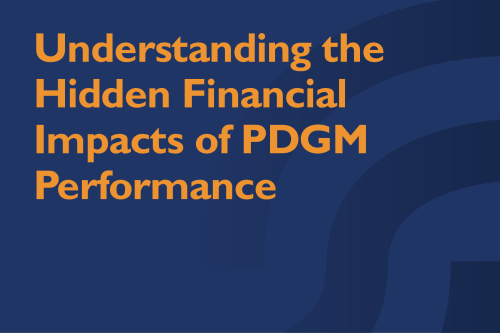Understanding the Hidden Financial Impacts of PDGM Performance

The Patient-Driven Groupings Model has fundamentally transformed home health reimbursement, creating both opportunities and challenges for agencies striving to maintain financial stability. Many organizations face mounting financial pressure without fully understanding the hidden impacts of their PDGM performance. Understanding these concealed financial factors has become increasingly critical for agencies seeking to optimize their operations while maintaining quality care delivery.
Explore discounted PDGM Analysis services today.
Uncovering Revenue Opportunities
The transition to PDGM created complex reimbursement pathways that many agencies haven’t fully explored. Without detailed analysis of case-mix weights, functional scoring patterns, and clinical documentation practices, organizations often miss opportunities to accurately capture the complexity of patient care. This oversight extends beyond simple coding accuracy to encompass multiple aspects of episode management.
Many agencies overlook revenue opportunities through:
- Suboptimal case-mix weight capture
- Incomplete functional scoring documentation
- Missed comorbidity adjustment opportunities
- Insufficient documentation of service complexity
- Incomplete support for patient care needs
Documentation and Coding Financial Exposure
The financial impact of documentation practices extends far beyond immediate reimbursement concerns. Incorrect or insufficient documentation creates both immediate and long-term financial exposure for agencies under PDGM. The complexity between diagnosis coding, functional assessments, and clinical documentation requires systematic analysis to ensure both accuracy and completeness.
Immediate Revenue Impact
Documentation gaps directly affect payment accuracy through:
- Case-mix weight determination
- Functional score calculation
- Clinical grouping assignment
- Comorbidity adjustment capture
Long-term Financial Risks
Beyond immediate payment concerns, poor documentation practices increase vulnerability to:
- Payment audits and reviews
- Revenue recoupment demands
- Compliance challenges
- Ongoing financial instability
Quality Metrics and Market Position
The financial impact of PDGM performance extends well beyond direct reimbursement to affect broader market success and sustainability. This connection creates multiple pathways for financial impact that many agencies fail to recognize.
STAR Rating Financial Impact
Poor STAR ratings increasingly influence both referral patterns and value-based purchasing outcomes. As healthcare networks and consumers become more selective, agencies with poor quality metrics face growing competitive challenges that directly affect their financial performance through:
- Reduced referral volumes
- Network participation limitations
- Competitive disadvantages
- Market share erosion
Value-Based Purchasing Consequences
Value-based purchasing creates direct financial consequences for performance across multiple domains. The relationship between PDGM performance and VBP success requires careful attention to:
- Quality measure achievement
- Patient outcome optimization
- Documentation accuracy
- Performance metric alignment
The Cost of Delayed Intervention
Organizations that wait to address performance issues face more complex remediation challenges and mounting financial pressure. The cost of delayed intervention often exceeds the investment required for proactive monitoring and optimization.
Compounding Financial Impact
Delayed investigation and intervention compound home health financial challenges through:
- Lost revenue opportunities
- Mounting documentation issues
- Growing compliance risks
- Increasing quality concerns
- Declining market position
Sustainability Concerns
The cumulative impact of suboptimal PDGM performance threatens long-term organizational sustainability. As market pressures increase and regulatory requirements evolve, agencies without necessary analytical capabilities face growing challenges in maintaining financial stability and competitive position.
How SimiTree Can Help
Book your discounted PDGM Analysis today. With over 1,100 industry experts serving more than 15,900 agencies, SimiTree brings proven methodologies and deep expertise to help organizations optimize their PDGM performance and financial outcomes. Our expert team combines specialized knowledge with extensive clinical, coding, and compliance expertise to deliver comprehensive optimization services, including:
- Full revenue impact evaluation and enhancement strategies
- Complete documentation and coding optimization support
- Comprehensive performance improvement programs
- Staff education and competency development
- Ongoing monitoring and analytics support
Our comprehensive support helps organizations achieve sustainable improvement in PDGM performance while maximizing reimbursement opportunities.
Contact us today to learn how SimiTree can help your organization maximize success under PDGM.
Frequently Asked Questions
How does PDGM performance affect agency revenue?
PDGM performance directly impacts revenue through case-mix weights, functional scores, clinical groupings, and comorbidity adjustments. Poor performance leads to missed reimbursement opportunities, increased audit risk, and potential payment recoupment.
What are the hidden costs of poor PDGM documentation?
Hidden PDGM documentation costs include missed revenue opportunities, increased audit vulnerability, potential payment recoupment, declining STAR ratings, and reduced referrals. These impacts compound over time, affecting both immediate revenue and long-term sustainability.
How do quality metrics impact financial performance under PDGM?
Quality metrics affect financial performance through value-based purchasing adjustments, referral patterns, network participation opportunities, and market competitiveness. Poor quality scores can lead to reduced revenue, fewer referrals, and declining market position.
References
Centers for Medicare & Medicaid Services & DEPARTMENT OF HEALTH AND HUMAN SERVICES. (2023, 11 13). Medicare Program; Calendar Year (CY) 2024 Home Health (HH) Prospective Payment System Rate Update; HH Quality Reporting Program Requirements; HH Value-Based Purchasing Expanded Model Requirements; Home Intravenous Immune Globulin Items and Services; Hospic. Federal Register, 88(217). https://www.govinfo.gov/content/pkg/FR-2023-11-13/pdf/2023-24455.pdf
Physician Guide to Medicare Home Health Changes: The Patient Driven Groupings Model. (n.d.). Physician Guide to Medicare Home Health Changes: The Patient Driven Groupings Model (PDGM). National Association for Home Care & Hospice. https://nahc.org/education/pdgm-physicians-toolkit/
U.S. Centers for Medicare & Medicaid Services. (n.d.). Centers for Medicare & Medicaid Services Patient-Driven Groupings Model. CMS. https://www.cms.gov/Medicare/Medicare-Fee-for-Service-payment/HomeHealthPPS/Downloads/Overview-of-the-Patient-Driven-Groupings-Model.pdf
U.S. Centers for Medicare & Medicaid Services. (2023, 03 29). Home Health Patient-Driven Groupings Model. CMS. https://www.cms.gov/medicare/payment/prospective-payment-systems/home-health/home-health-patient-driven-groupings-model

